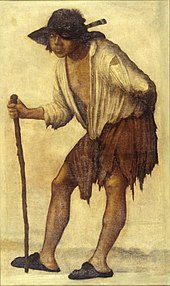Sturdy beggar
 From Wikipedia - Reading time: 5 min
From Wikipedia - Reading time: 5 min
This article needs additional citations for verification. (February 2013) |

In historical English law, a sturdy beggar was a person who was fit and able to work, but begged or wandered for a living instead.[1][2][3] The Statute of Cambridge 1388 was an early law which differentiated between sturdy beggars and the infirm (handicapped or elderly) poor. The Vagabonds and Beggars Act 1494 listed restrictions and punishments.
In the 1530s and into the 1540s, many English monasteries were closed, reducing resources available to the poor, and the Vagabonds Act 1530 empowered justices of the peace to issue licences to those unable to work, making begging by persons able to work a crime.[4][5]
Types of sturdy beggar included the Tom o'Bedlam, who would pretend to be mad and follow people around. People would give him money to go away. The bristler used loaded dice that would land on any number he chose. This way, he could cheat at dice. The Counterfeit Crank would use soap to foam at the mouth, and pretend to have violent fits.[6]
Unemployment carried the death penalty on repeat offences. In 16th-century England, no distinction was made between vagrants and the jobless; both were simply categorised as "sturdy beggars", who were to be punished and moved on.[7] In 1547, a bill was passed that subjected vagrants to some of the more extreme provisions of the criminal law: two years' servitude and branding with a "V" as the penalty for the first offence and death for the second.[8]
See also
[edit]References
[edit]- ^ Jutte, Robert. "Vagrants and Beggars". Gale Encyclopedia of the Early Modern World. Answers.com. Retrieved February 2, 2013.
- ^ Lambert, Tim (2012). "Poverty in the Middle Ages". A Brief History of Poverty. Retrieved February 2, 2013.
- ^ Mills, Louis R (December 1, 2012). "Time Line". Poor Law History. Gen UKI (Lincolnshire). Retrieved February 2, 2013.
- ^ "Key dates in Poor Law and Relief Great Britain 1300–1899". Key dates in the Sociological history and development of Great Britain. thepotteries.org. Retrieved February 2, 2013.
- ^ Deming, David (2016). Science and Technology in World History. Vol. 4. McFarland. p. 252. ISBN 9781476625041.
- ^ Campisi, Megan (2020-04-03). "A Guide to Elizabethan Con Games - Strand Magazine". Strand Mag. Retrieved 2023-01-28.
- ^ "Sturdy Beggars". Probertencyclopaedia.com. Archived from the original on 8 June 2011. Retrieved 22 July 2009.
- ^ R. O. Bucholz, Newton Key, Early modern England, 1485–1714, p176
External resources
[edit]
 KSF
KSF